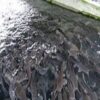- このトピックは空です。
- 投稿者投稿
- 3月 20, 2025 9:02 am #598200

While the charm and simplicity of an earthen pond evoke a sense of natural harmony, it’s essential to acknowledge the practical challenges.
Understanding the Disadvantages Of Having An Earthen Pond allows for informed decision-making and proactive management, ensuring that the pond’s benefits outweigh its potential drawbacks. The rustic allure of an earthen pond comes with a unique set of considerations.
1. Water Seepage and Loss
Earthen ponds are susceptible to water seepage, leading to significant water loss. The porous nature of the soil allows water to percolate through the pond’s bottom and sides. This can be particularly problematic in areas with sandy or gravelly soils.
Continuous water loss requires frequent replenishment, which can be costly and unsustainable. Seepage issues can also lead to fluctuations in water levels, affecting aquatic life.
2. Difficulty in Water Quality Management
Maintaining optimal water quality in an earthen pond can be challenging. The natural soil bottom can release nutrients and organic matter, leading to increased turbidity and algal blooms.
Controlling parameters like pH, dissolved oxygen, and ammonia levels requires constant monitoring and intervention. It can be difficult to achieve and maintain stable water conditions. The lack of a liner makes water quality control more difficult.
3. Susceptibility to Erosion and Bank Instability
Earthen pond banks are prone to erosion, particularly from wave action, rainfall, and animal activity. Erosion can lead to sediment buildup in the pond and destabilize the banks, reducing the pond’s capacity.
Repairing eroded banks can be labor-intensive and costly. The stability of the banks can also be compromised by burrowing animals.
4. Limited Control Over Fish Stocking and Harvesting
Managing fish populations in an earthen pond can be difficult. It’s challenging to control the breeding and growth of fish, as well as to harvest them efficiently. Natural predators and competing species can also impact fish populations.
Harvesting fish from an earthen pond often requires draining the pond, which can be disruptive and stressful for aquatic life. The lack of a controlled environment makes fish management complex.
5. Increased Risk of Leaks and Repairs
Earthen ponds are more susceptible to leaks and damage compared to lined ponds. Tree roots, burrowing animals, and soil shifting can create leaks that are difficult to locate and repair.
Repairing leaks in an earthen pond often requires draining the pond and patching the affected area. This can be time-consuming and costly, potentially disrupting the pond’s ecosystem.
The Disadvantages Of Having An Earthen Pond highlight the importance of careful planning and management. While offering a natural aesthetic and ecological benefits, they also present challenges related to water seepage, water quality, erosion, fish management, and repairs.
Understanding these drawbacks is essential for mitigating risks and ensuring the long-term sustainability of an earthen pond.
Read Also: The Hidden Challenges: Disadvantages of Concrete Pond Construction
- 投稿者投稿
- このトピックに返信するにはログインが必要です。






